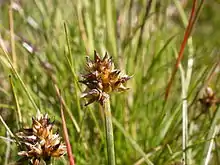bjúgstör
Icelandic

Bjúgstör
Pronunciation
- IPA(key): /ˈpjuɣ.stœːr/
Noun
bjúgstör f (genitive singular bjúgstarar, nominative plural bjúgstarir)
- curved sedge (Carex maritima)
- 1902, Einar Helgason, “Sandfokið í Sauðlauksdal [Sandstorm in Sauðlauksdalur]”, in Búnaðarrit, volume 16, number 1, page 90:
- Niður á láglendinu er língresið orðið útbreiddast, það breiðir sig þar yfir sandinn og bindur hann; þar vex einnig vingull, sveifgras, mýrastör, bjúgstör, fífa, kattartunga, mýrasóley, grávíðir, kornsúra.
- Down in the lowlands bentgrass has become widespread, it spreads itself over the sand and binds to it; there also grows fescue, meadow-grass, black sedge, curved sedge, cottongrass, sea plantain, bog-star, arctic willow, Alpine bistort.
- 1938, “Frá óbyggðum [From the wilderness]”, in Andvari, volume 63, number 1, page 51:
- Kvað þar mest að sauðvingli, bjúgstör og öðrum þurrlendisjurtum.
- (please add an English translation of this quote)
- 1980 January 24, Ingólfur Davíðsson, “Blaðperlur og beysin epli”, in Tíminn, volume 64, number 19, page 9:
- Blómið til vinstri er lokasjóður (peningagras), bjúgstarir i miðju og fífa t.h.
- The flower to the left is the yellow rattle, curved sedges in the middle and cottongrass to the right.
-
Declension
declension of bjúgstör
| f-s2 | singular | plural | ||
|---|---|---|---|---|
| indefinite | definite | indefinite | definite | |
| nominative | bjúgstör | bjúgstörin | bjúgstarir | bjúgstarirnar |
| accusative | bjúgstör | bjúgstörina | bjúgstarir | bjúgstarirnar |
| dative | bjúgstör | bjúgstörinni | bjúgstörum | bjúgstörunum |
| genitive | bjúgstarar | bjúgstararinnar | bjúgstara | bjúgstaranna |
This article is issued from Wiktionary. The text is licensed under Creative Commons - Attribution - Sharealike. Additional terms may apply for the media files.